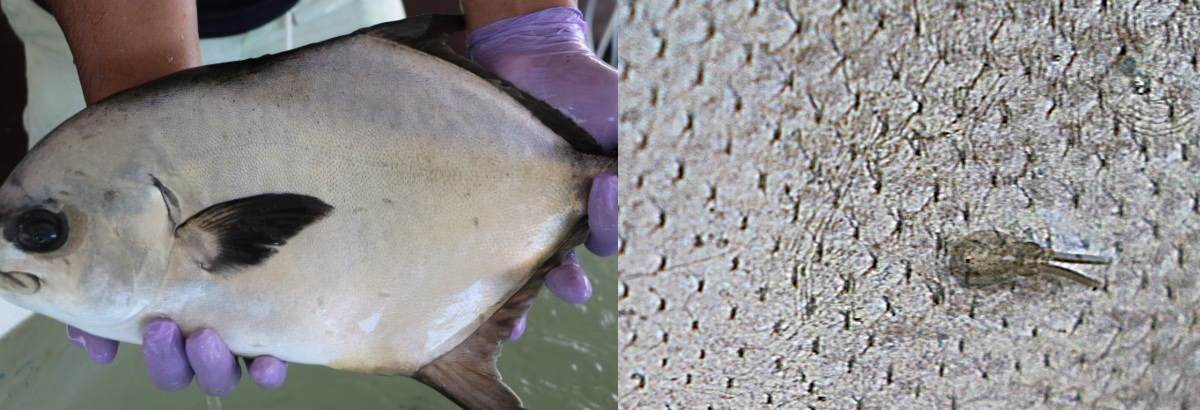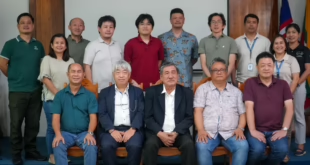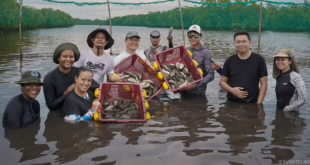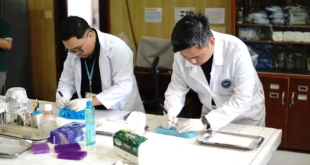Do fish need baths? Perhaps not one with soap and water, but itchy pompano might need a bath in hydrogen peroxide.
The commercial production of pompano in the Philippines may not be as big as that of tilapia or milkfish, but it is developing. And with development comes challenges. There are increasing reports of sea lice infecting pompano grown in fish cages.
Sea lice are parasites that infest the fish, wounding them, and lowering their appeal in the market. Sea lice-related wounds also become entry points for bacteria or fungi, causing secondary infections, and even death.
Ms. Gregoria Pagador, a retired associate scientist at SEAFDEC/AQD, knows that hydrogen peroxide (H₂O₂) has been widely used in controlling sea lice in temperate aquaculture. She and her team conducted experiments to test how well this would work with snubnose pompano (Trachinotus blochii) in tropical conditions.
Adult pompano in marine cages found to be naturally infested with sea lice (Lepeophtheirus spinifer) were divided into three treatment groups. Two groups of fish were given H₂O₂ baths for 20 minutes at two different concentrations (1500 ppm and 2000 ppm). The third group acted as the control group which did not receive an H₂O₂ bath.
After the bath, the fish were returned to their cages and monitored for reinfestation. Lice that had detached from the fish were also monitored to see if they were still alive after the treatment.
So, did it work? The results show that the bath was successful in reducing the number of lice infesting the fish.
Before taking the bath, the average fish had about 26.7 lice. Three days after taking the bath, lice intensity dropped to an average of 1.6 lice per fish for the group tested with 1500 ppm H₂O₂ and 1.2 lice per fish for the group tested with 2000 ppm H₂O₂. Adult female lice, in particular, were eliminated entirely. Furthermore, all the lice that were exposed to the H₂O₂ bath died within 12 hours.
More importantly, none of the pompano died or were observed to have any negative response to the treatment demonstrating that the H₂O₂ concentrations were safe for the fish.
There were, however, some limitations to its efficacy. Since the fish are raised in an open cage environment, they were observed to be infested with sea lice again after a week. Additionally, copepodids, or the larval stage of the lice, were found to have very little difference in intensity among the groups including the control group.
This study establishes the efficacy of H₂O₂ in reducing sea lice infestations in raising pompano, paving the way for further research on optimizing the method and possibly integrating them into aquaculture practices.
If you wish to know more about the study, you can read the article entitled “Field evaluation of hydrogen peroxide bath technique for controlling sea lice (Lepeoptheirus spinifer) infestation in snubnose pompano (Trachinotus blochii)” which was published in the journal Veterinary Parasitology in 2024. You may request for a copy of the article here: https://repository.seafdec.org.ph/handle/10862/6537
DISCLAIMER: These results are from experiments. To treat parasitic infections in your farms, refer to established treatments published in the “Manual on important marine parasites and their hosts in the Philippines,” authored by Ms. Pagador, which may be downloaded here: https://repository.seafdec.org/handle/20.500.12066/7501


 SEAFDEC/AQD Southeast Asian Fisheries Development Center | Aquaculture Department
SEAFDEC/AQD Southeast Asian Fisheries Development Center | Aquaculture Department



